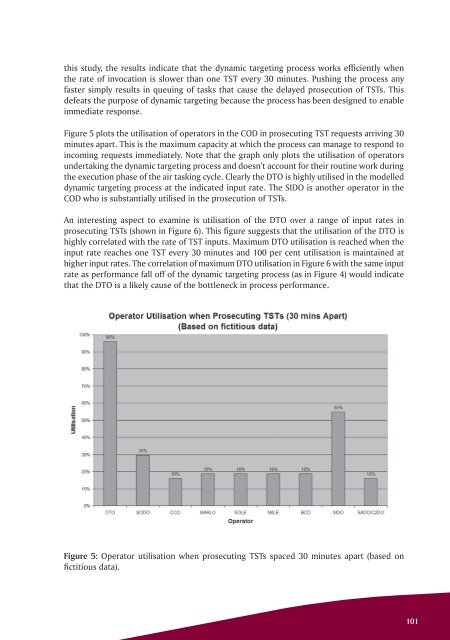ISSUE 176 : Jul/Aug - 2008 - Australian Defence Force Journal
ISSUE 176 : Jul/Aug - 2008 - Australian Defence Force Journal
ISSUE 176 : Jul/Aug - 2008 - Australian Defence Force Journal
You also want an ePaper? Increase the reach of your titles
YUMPU automatically turns print PDFs into web optimized ePapers that Google loves.
this study, the results indicate that the dynamic targeting process works efficiently when<br />
the rate of invocation is slower than one TST every 30 minutes. Pushing the process any<br />
faster simply results in queuing of tasks that cause the delayed prosecution of TSTs. This<br />
defeats the purpose of dynamic targeting because the process has been designed to enable<br />
immediate response.<br />
Figure 5 plots the utilisation of operators in the COD in prosecuting TST requests arriving 30<br />
minutes apart. This is the maximum capacity at which the process can manage to respond to<br />
incoming requests immediately. Note that the graph only plots the utilisation of operators<br />
undertaking the dynamic targeting process and doesn’t account for their routine work during<br />
the execution phase of the air tasking cycle. Clearly the DTO is highly utilised in the modelled<br />
dynamic targeting process at the indicated input rate. The SIDO is another operator in the<br />
COD who is substantially utilised in the prosecution of TSTs.<br />
An interesting aspect to examine is utilisation of the DTO over a range of input rates in<br />
prosecuting TSTs (shown in Figure 6). This figure suggests that the utilisation of the DTO is<br />
highly correlated with the rate of TST inputs. Maximum DTO utilisation is reached when the<br />
input rate reaches one TST every 30 minutes and 100 per cent utilisation is maintained at<br />
higher input rates. The correlation of maximum DTO utilisation in Figure 6 with the same input<br />
rate as performance fall off of the dynamic targeting process (as in Figure 4) would indicate<br />
that the DTO is a likely cause of the bottleneck in process performance.<br />
Figure 5: Operator utilisation when prosecuting TSTs spaced 30 minutes apart (based on<br />
fictitious data).<br />
101

















